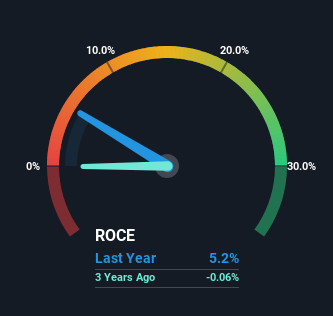Chugai Ro (TSE:1964) Will Want To Turn Around Its Return Trends

There are a few key trends to look for if we want to identify the next multi-bagger. Ideally, a business will show two trends; firstly a growing return on capital employed (ROCE) and secondly, an increasing amount of capital employed. This shows us that it's a compounding machine, able to continually reinvest its earnings back into the business and generate higher returns. In light of that, when we looked at Chugai Ro (TSE:1964) and its ROCE trend, we weren't exactly thrilled.
What Is Return On Capital Employed (ROCE)?
Just to clarify if you're unsure, ROCE is a metric for evaluating how much pre-tax income (in percentage terms) a company earns on the capital invested in its business. To calculate this metric for Chugai Ro, this is the formula:
Return on Capital Employed = Earnings Before Interest and Tax (EBIT) ÷ (Total Assets - Current Liabilities)
0.052 = JP¥1.4b ÷ (JP¥46b - JP¥19b) (Based on the trailing twelve months to December 2023).
Thus, Chugai Ro has an ROCE of 5.2%. In absolute terms, that's a low return and it also under-performs the Machinery industry average of 7.9%.
View our latest analysis for Chugai Ro

While the past is not representative of the future, it can be helpful to know how a company has performed historically, which is why we have this chart above. If you'd like to look at how Chugai Ro has performed in the past in other metrics, you can view this free graph of Chugai Ro's past earnings, revenue and cash flow.
What Does the ROCE Trend For Chugai Ro Tell Us?
In terms of Chugai Ro's historical ROCE movements, the trend isn't fantastic. Over the last five years, returns on capital have decreased to 5.2% from 7.4% five years ago. However, given capital employed and revenue have both increased it appears that the business is currently pursuing growth, at the consequence of short term returns. If these investments prove successful, this can bode very well for long term stock performance.
On a side note, Chugai Ro's current liabilities are still rather high at 41% of total assets. This effectively means that suppliers (or short-term creditors) are funding a large portion of the business, so just be aware that this can introduce some elements of risk. Ideally we'd like to see this reduce as that would mean fewer obligations bearing risks.
The Key Takeaway
In summary, despite lower returns in the short term, we're encouraged to see that Chugai Ro is reinvesting for growth and has higher sales as a result. And the stock has followed suit returning a meaningful 87% to shareholders over the last five years. So while investors seem to be recognizing these promising trends, we would look further into this stock to make sure the other metrics justify the positive view.
If you'd like to know about the risks facing Chugai Ro, we've discovered 2 warning signs that you should be aware of.
While Chugai Ro isn't earning the highest return, check out this free list of companies that are earning high returns on equity with solid balance sheets.
New: AI Stock Screener & Alerts
Our new AI Stock Screener scans the market every day to uncover opportunities.
• Dividend Powerhouses (3%+ Yield)
• Undervalued Small Caps with Insider Buying
• High growth Tech and AI Companies
Or build your own from over 50 metrics.
Have feedback on this article? Concerned about the content? Get in touch with us directly. Alternatively, email editorial-team (at) simplywallst.com.
This article by Simply Wall St is general in nature. We provide commentary based on historical data and analyst forecasts only using an unbiased methodology and our articles are not intended to be financial advice. It does not constitute a recommendation to buy or sell any stock, and does not take account of your objectives, or your financial situation. We aim to bring you long-term focused analysis driven by fundamental data. Note that our analysis may not factor in the latest price-sensitive company announcements or qualitative material. Simply Wall St has no position in any stocks mentioned.
About TSE:1964
Chugai Ro
Engages in the development of technologies in the thermal technology field in Japan and internationally.
Excellent balance sheet average dividend payer.


